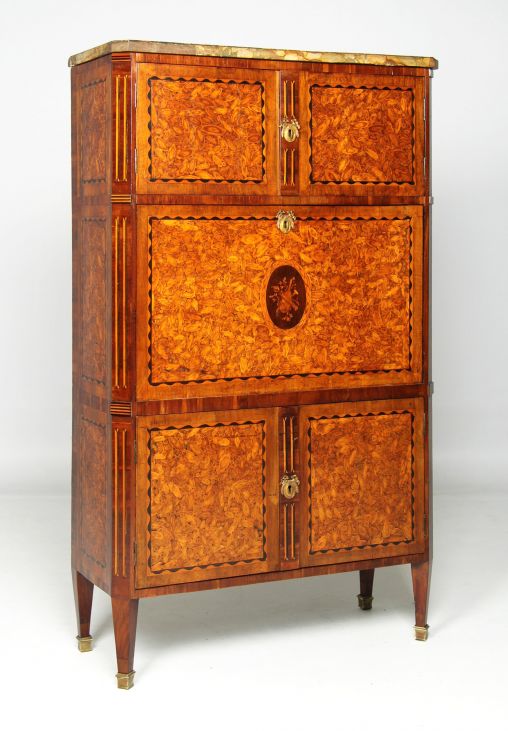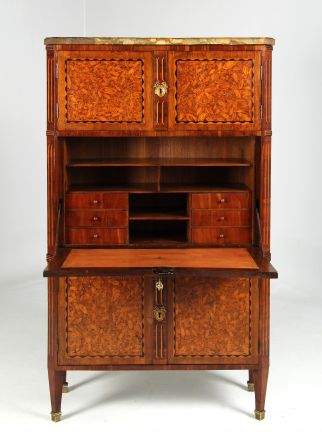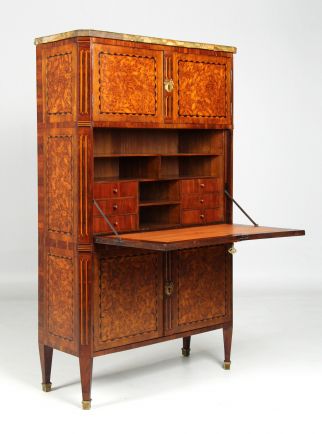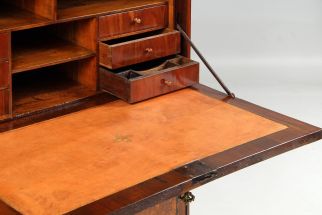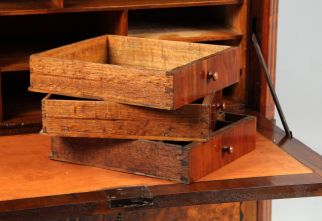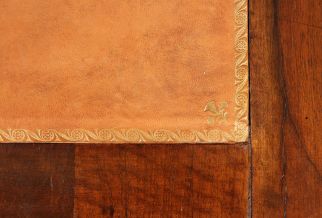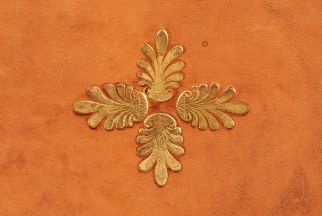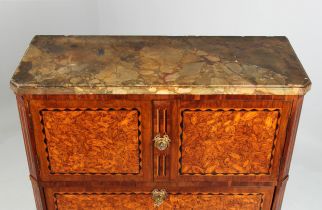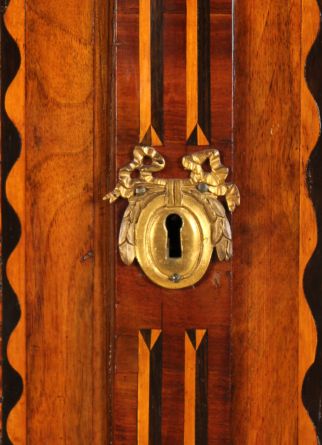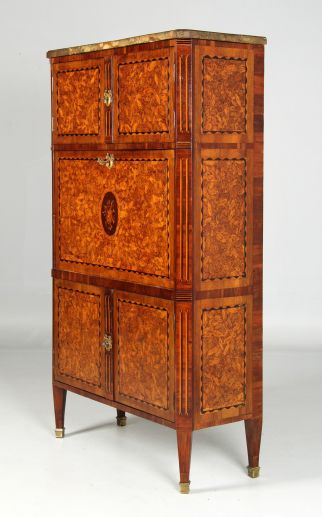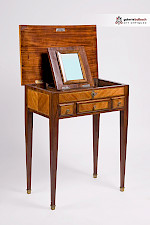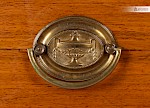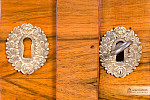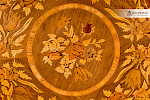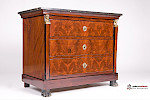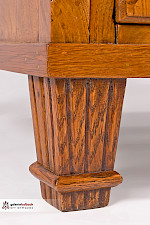Secrétaire à abattant with oyster veneer
France (Dauphine region)
various precious woods
Late 18th century
Dimensions: H x W x D: 165 cm x 95 cm x 39 cm
Description:
This superb secretaire à abattant (also known as a fall-front secretaire) was made in the late 18th century in south-east France. Its elegant design reflects refined aesthetics and stands as an exemplar of the Louis XVI style, in vogue between 1774 and 1793, characterised by symmetry, straight lines, and classical- inspired ornamentation.
The piece of furniture stands on four slender, tapered square legs decorated with ormolu sabots. There are ormolu escutcheons around the keyholes. The fittings, decorated with garlands and ribbons, protect the areas underneath.
The tall, rectangular body with a loose marble top is decorated with various veneer techniques. Most prominent is the oyster veneer, likely crafted from fruit or olive wood branches, visible on the front and side panels.
This distinctive techniqueinvolves cutting smaller tree branches transversely at an oblique angle, producing oval slices that resemble oyster shells, hence the name. Oyster veneering first emerged in the late 17th century and reached peak popularity in England between 1670 and 1710 during the William and Mary era. It was cut from larger branches such as olive, walnut and kingwood and laid symmetrically.
The veneer technique with very small twigs seen on the secretary offered here was not created until a good 100 years later and is associated with the master craftsman Jean Francois Hache (1730-1796), who was based in Grenoble, France. Hache, whose furniture was mainly made from local woods such as walnut, sycamore, poplar, lime, wisteria and fruitwood, focussed his work on the decorative aspect of the veneers and marquetry. His fine marquetry such as vases, urns, flower garlands and medallions with musical or garden instruments stand out against backgrounds of burl or root wood.
Due to the intricate process and rarity of suitable timbers, such decoration was more costly to produce, so that only a few pieces of furniture decorated in this way were made and they are accordingly rare in the art trade today. A few are stamped with ‘Hache - Fils’ or ‘Hache a Grenoble’.
The oyster veneered panels are framed with a dual-colour wavy parquetry border, which is itself outlined by crossbanding. The crossbars and their extension on the sides are veneered in plum.
There is a central pilaster between each pair of doors, which, like the pilaster strips of the furniture, is inlaid with a linear marquetry. The light and dark contrasting woods create a kind of shadow effect, so that the inlays are reminiscent of fluting, a design element frequently used at the time.
The veneered fall-front of the secrétaire features a dainty, oval medallion framed by a delicate interlacing dotted border. Light-coloured, finely engraved marquetry depicts a torch and musical instruments.
The upper section includes a pair of lockable doors that open to reveal a spacious compartment with a single shelf. A similar, yet larger storage area is found in the lower section.
Between these lies the fall-front panel, which opens to reveal a leather-lined, gilt-tooled writing surface. Above it are two shelves flanked by three drawers on each side, topped by three additional open shelves. Enhancing the functionality are various compartments for storing ink and grit jars within the small drawers.
Secrétaires à abattant were first introduced in France in the 1760s. Unlike many of their writing furniture predecessors, they were designed to be placed against a wall, hence the lack of decoration on their reverse.
Condition:
Refurbished with a classic shellac hand polish to preserve the patina. Stable and suitable for everyday use.
Examples of comparable objects can be found in the specialised literature:
Pierre Kjellberg - Le Mobilier Francais Du XVIIIe Siecle p. 406 and p. 421
Also recommended on the subject is:
Edith Mannoni - Mobilier Savoyard & Dauphinois
Article found under: Secretaries
Video secretary with oyster veneer
Also interesting
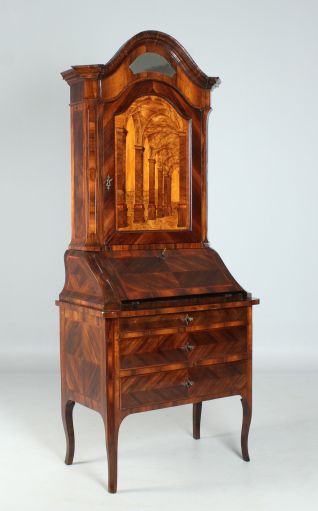
Secretary with Architectural Marquetry
Italy
Rosewood a.o.
second half 18th century
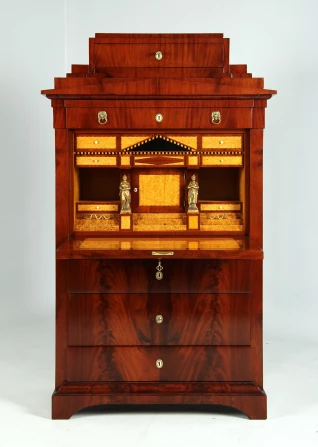
Very elaborate Berlin secretary
Berlin
Mahogany a.o.
around 1825
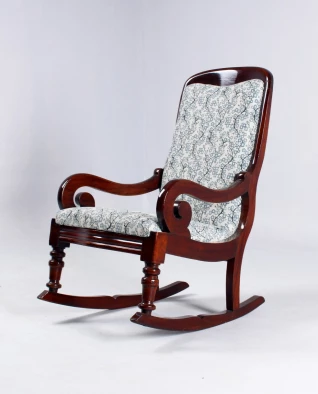
Antique rocking chair
North Germany
Mahogany
Late Biedermeier c. 1840
